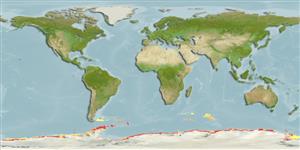Demospongiae |
Polymastiida |
Polymastiidae
Environment: milieu / climate zone / depth range / distribution range
Ecology
Sessile; depth range 17 - 450 m (Ref. 89939). Polar
Circumantarctic.
Length at first maturity / Size / Weight / Age
Maturity: Lm ? range ? - ? cm
Dome-shaped or spheroidal. Dense short piles of cortical microtyles present on surface, with several usually elongated papillae with or without a large terminal orifice. Cortex with dermal pores, with each pore opening into one tubular canal (Ref. 089939).
Inhabits mostly hard bottoms; occasional on mud (Ref. 089939).
Life cycle and mating behavior
Maturity | Reproduction | Spawning | Eggs | Fecundity | Larvae
Members of the class Demospongiae are hermaphroditic. Life cycle: The zygote develops into parenchymella larva (free-swimming) before settling down on a substrate where it grows into a young sponge.
Southern Ocean Mollusc Database (SOMBASE) 2011 British Antarctic Survey, SOMBASE. Accessed through GBIF data portal, http://data.gbif.org/datasets/resource/66, 2011-07-15. (Ref. 87340)
IUCN Red List Status
(Ref. 130435: Version 2025-1)
CITES status (Ref. 108899)
Not Evaluated
Not Evaluated
Threat to humans
Harmless
Human uses
| FishSource |
Tools
More information
Trophic EcologyFood items (preys)
Diet composition
Food consumption
Predators
Population dynamicsGrowthMax. ages / sizesLength-weight rel.Length-length rel.Length-frequenciesMass conversionAbundance Life cycleReproductionMaturityFecunditySpawningEggsEgg developmentLarvae PhysiologyOxygen consumption
Human RelatedStamps, coins, misc.
Internet sources
Estimates based on models
Preferred temperature
(Ref.
115969): -1.8 - 1.2, mean -1.2 (based on 300 cells).
